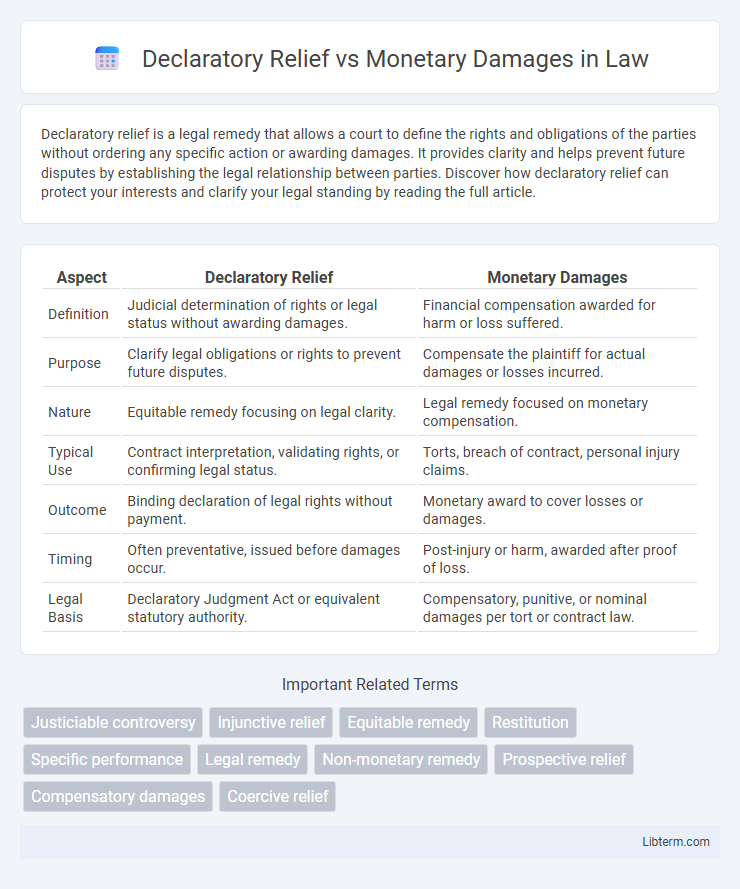Declaratory relief is a legal remedy that allows a court to define the rights and obligations of the parties without ordering any specific action or awarding damages. It provides clarity and helps prevent future disputes by establishing the legal relationship between parties. Discover how declaratory relief can protect your interests and clarify your legal standing by reading the full article.
Table of Comparison
| Aspect | Declaratory Relief | Monetary Damages |
|---|---|---|
| Definition | Judicial determination of rights or legal status without awarding damages. | Financial compensation awarded for harm or loss suffered. |
| Purpose | Clarify legal obligations or rights to prevent future disputes. | Compensate the plaintiff for actual damages or losses incurred. |
| Nature | Equitable remedy focusing on legal clarity. | Legal remedy focused on monetary compensation. |
| Typical Use | Contract interpretation, validating rights, or confirming legal status. | Torts, breach of contract, personal injury claims. |
| Outcome | Binding declaration of legal rights without payment. | Monetary award to cover losses or damages. |
| Timing | Often preventative, issued before damages occur. | Post-injury or harm, awarded after proof of loss. |
| Legal Basis | Declaratory Judgment Act or equivalent statutory authority. | Compensatory, punitive, or nominal damages per tort or contract law. |
Understanding Declaratory Relief: Definition and Purpose
Declaratory relief is a judicial determination that clarifies the legal rights, duties, or obligations of the parties involved without awarding damages or ordering specific action. It serves to resolve legal uncertainty and prevent future disputes by providing a binding statement on the parties' legal status or interpretation of a contract or statute. Unlike monetary damages, declaratory relief focuses on establishing legal clarity rather than compensating for harm.
What Are Monetary Damages? Overview and Types
Monetary damages refer to financial compensation awarded to a plaintiff in a legal dispute to cover losses or injuries incurred due to the defendant's actions. The primary types include compensatory damages, intended to reimburse actual losses such as medical expenses and lost wages; punitive damages, designed to punish and deter particularly egregious conduct; and nominal damages, which recognize a legal wrong without significant financial loss. These damages contrast with declaratory relief, which seeks a court's determination on the legal rights of parties without awarding money.
Key Differences: Declaratory Relief vs Monetary Damages
Declaratory relief involves a court judgment that defines the legal rights or obligations of parties without ordering any specific action or awarding money, often used to prevent future disputes. Monetary damages require the defendant to pay a sum of money to compensate the plaintiff for harm or loss suffered. The key difference lies in declaratory relief clarifying legal positions, while monetary damages provide financial compensation for proven injury.
When to Seek Declaratory Relief in Legal Disputes
Seek declaratory relief in legal disputes when parties require a judicial determination of their rights, duties, or obligations without seeking monetary compensation. This remedy is essential for resolving uncertainties, preventing future legal conflicts, and clarifying contractual interpretations or regulatory compliance. Declaratory relief is particularly effective in cases involving ongoing relationships or potential breaches where the goal is to establish legal clarity rather than to recover damages.
Situations Favoring Monetary Damages
Monetary damages are favored in situations where plaintiffs seek compensation for financial losses, such as breach of contract or personal injury cases. These damages aim to restore the injured party to the financial position they would have been in had the harm not occurred. When direct financial harm is quantifiable and the primary goal is economic recovery, courts are more likely to award monetary damages rather than declaratory relief.
Benefits and Risks of Declaratory Relief
Declaratory relief provides a judicial determination of parties' rights without awarding monetary damages, offering benefits such as clarifying legal obligations and preventing future disputes by establishing clear legal positions. It minimizes immediate financial exposure and can expedite resolution through a binding court declaration, but risks include limited enforceability if parties do not comply voluntarily and the inability to recover actual losses or compensation. This remedy is particularly useful in contract disputes, intellectual property cases, and situations where parties seek legal certainty before further action.
Pros and Cons of Pursuing Monetary Damages
Pursuing monetary damages provides financial compensation that can directly address losses and incentivize the defendant to comply with legal obligations. However, the process often involves lengthy litigation, uncertain outcomes, and significant legal costs, which may outweigh potential recovery. Unlike declaratory relief, monetary damages may not resolve ongoing disputes or provide clear guidance on rights and responsibilities.
Legal Requirements for Declaratory Relief
Declaratory relief requires a genuine case or controversy where an actual legal dispute exists, and the party seeking relief must demonstrate an immediate need for a judicial determination to clarify rights or obligations. Courts generally require that the declaratory judgment will resolve uncertainty and prevent future litigation, ensuring the issue is concrete rather than hypothetical. Unlike monetary damages, declaratory relief does not involve awarding financial compensation but establishes the legal status or interpretation of a law or contract.
Procedural Steps: Claiming Monetary Damages
Claiming monetary damages involves filing a formal complaint outlining the specific financial harm suffered and the legal basis for the claim. The plaintiff must provide evidence of actual losses and demonstrate causation between the defendant's actions and the incurred damages. The court then assesses the validity of the claim through pleadings, discovery, and trial before determining the appropriate compensation amount.
Comparative Analysis: Choosing the Right Legal Remedy
Declaratory relief establishes the legal rights and duties of parties without awarding monetary compensation, serving as a proactive tool for preventing future disputes or clarifying existing uncertainties. Monetary damages provide financial compensation for losses suffered due to a breach or wrongdoing, focusing on remedying past harm. Choosing between declaratory relief and monetary damages depends on the case goals: declaratory relief is ideal for resolving ambiguities and securing legal certainty, while monetary damages are suited for situations requiring restitution for proven economic injury.
Declaratory Relief Infographic

 libterm.com
libterm.com